This is a trail that was pushed through by cat many decades ago to bring supplies to crews fighting forest fires in the interior... that may not sound promising, but it's now a nicely grown-in trail, usually wide enough for 2 abreast, and with enough sun penetrating for there to be lots of flowers along the trail. (Actually it's a better trail than most of those created by horsepackers, meaning that it goes continually uphill in a business-like way without meandering pointlessly up and down!)
Starting down in the forest...
A bad fuzzy picture of ground-cedar, Lycopodium complanatum showing cones, in the company of Linnaea borealis:
Walking along the trail, there were dense expanses of bunchberry, twinflower, and many Pyrola in bloom, and coming to the higher elevations in the forest in a wet clearing, Veratrum viride var. eschscholtzianum (as it is now called):



In the same area, I saw the most colourful bronzebells (formerly Stenanthium occidentale, now Anticlea occidentalis) I've ever seen... perhaps the effect of sunlight as compared to the more usual filtered light in the forest:
Continuing up, Rhododendron albiflorum: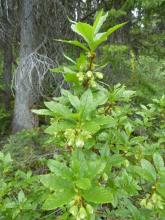

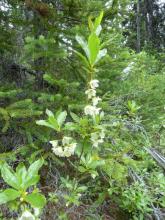
And, showing that this is quite a damp forest floor, Rhododendron/Ledum groenlandicum:

Comments
Lori S. (not verified)
Re: Taylor Lake - Panorama Meadows, Banff N.P., Aug. 2/11
Wed, 08/03/2011 - 10:57amMore Rhododendron albiflorum:
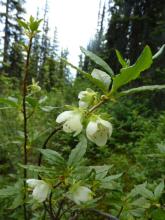
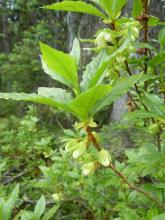
And finally topping out in the subalpine zone... these pictures fail to show how incredibly floriferous it was!
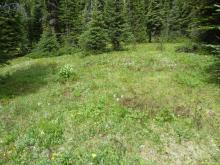
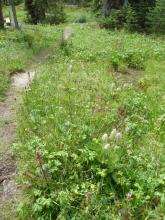
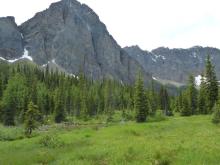
Agoseris aurantiacus, pink form, in the area around Taylor Lake (formerly Agoseris lackschewitzii and now called Agoseris aurantiacus var. aurantiacus, according to The Plant List)
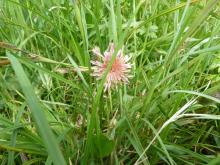
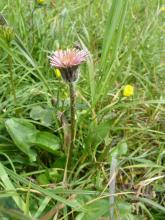
And Taylor Lake... a waterfall at the distant end. It's the site of a tiny campground (~4? sites), a couple of picnic tables, food pole, and outhouse...
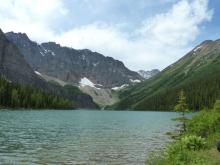
Lori S. (not verified)
Re: Taylor Lake - Panorama Meadows, Banff N.P., Aug. 2/11
Wed, 08/03/2011 - 11:34amLousewort, Pedicularis bracteosa, in the wet meadows around the lake:

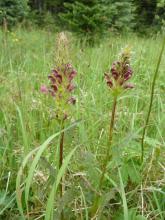
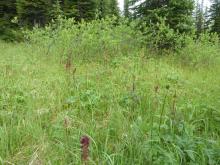
And Kalmia microphylla:
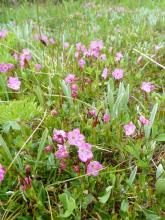
Climbing up through more forest to the meadows above the lake... an absolutely astounding density of bloom (that is poorly conveyed by these inadequate photos)!

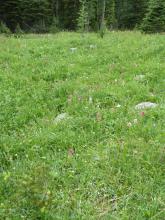
Rock garden, in a sea of white mountain heather, Cassiope mertensiana:
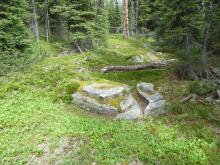
Valeriana sitchensis:
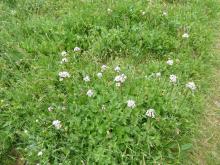

Lori S. (not verified)
Re: Taylor Lake - Panorama Meadows, Banff N.P., Aug. 2/11
Wed, 08/03/2011 - 11:53amThe usual(!) amazing variety of colour forms (species?) of Castilleja:
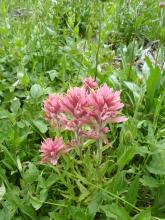
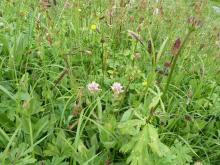

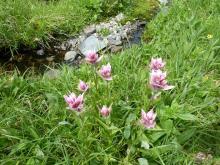
Lori S. (not verified)
Re: Taylor Lake - Panorama Meadows, Banff N.P., Aug. 2/11
Wed, 08/03/2011 - 12:04pmMeadow:
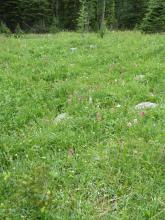
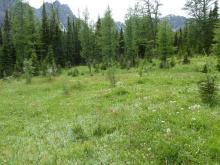
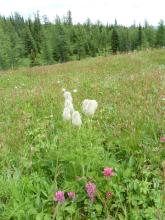
Veronica wormskjoldii:
Trond Hoy
Re: Taylor Lake - Panorama Meadows, Banff N.P., Aug. 2/11
Wed, 08/03/2011 - 12:27pmI am impressed! Although I am used to spruce, pine and mixed forests I have never sen anything like this here in Norway. The Norwegian forests are usually very species poor. Vaccinium myrtillus often covers large areas and moss and grasses dominate other areas. This is probably due to the mostly acidic bedrock and soil.
To name just one of the many interesting plants: Bronzebells is now on my wishlist ;D
Lori S. (not verified)
Re: Taylor Lake - Panorama Meadows, Banff N.P., Aug. 2/11
Wed, 08/03/2011 - 2:12pmMaking our way through the meadow...
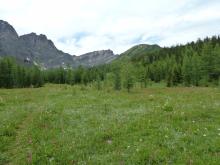
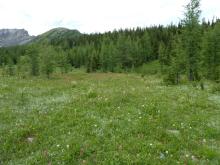
To where the stream rushes down from the tarns and snowmelt above... Saxifraga lyallii in bloom on the mid-stream rock:
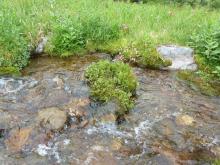
Caltha leptosepala at home with its feet wet (although in the garden here, it tolerates rather dry conditions):
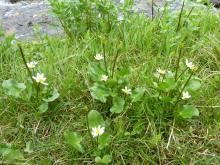
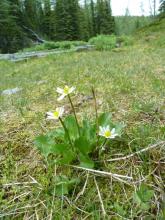
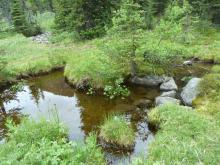
And Senecio triangularis, also enjoying the wet habitat:
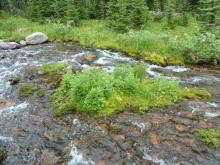
Phyllodoce empetriformis, growing on hummocks and rocks:
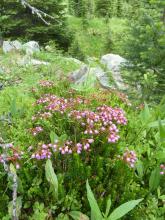
Claytonia lanceolata:
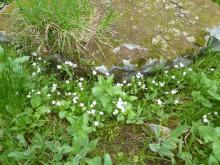
Stream:

Lori S. (not verified)
Re: Taylor Lake - Panorama Meadows, Banff N.P., Aug. 2/11
Wed, 08/03/2011 - 2:30pmAnd, for those who are paying attention ( ;)), if you noticed the ubiquitous seedheads of "towhead babies"* (Anemone occidentalis) in the meadow photos earlier, you may note that this seedhead is much less advanced... hmmm. (N.B. Not meaning to give away all my secrets, but I am using a literary device known as foreshadowing here... ;D)
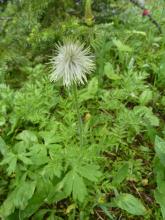
Mitella nuda, flourishing in the moist soil:

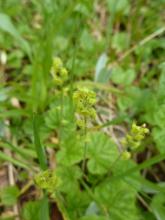
The beautiful foliage of coltsfoot, Petasites frigidus v. nivalis
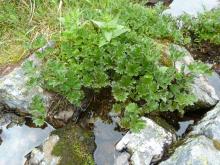
vitifolius:And we emerge out of the edging forest to the talus-bound tarns above:

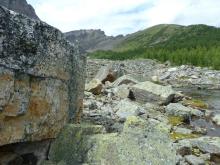
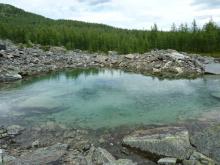
Talus... quartzite blocks covered in lichen, and slately slabs:
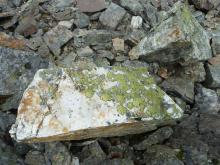
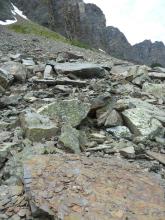
*I read an account in which someone also referred to them, amusingly, as "hippies on a stick".
Richard T. Rodich
Re: Taylor Lake - Panorama Meadows, Banff N.P., Aug. 2/11
Wed, 08/03/2011 - 4:07pmA delight, as usual, Lori!
The flowers are not terminal on Rhododendron albiflorum? I didn't know there was such a thing in the genus. Perhaps a work around adaptation to getting its terminal buds eaten by various winter browsing animals?
Taylor Lake's falls (Taylor's Falls?) must be really big. I'm very impressed, even after seeing those in Trond's South American adventure.
Okay, I've seen Valeriana sitchensis a few different times in situ on this forum, and I still like it. Does anyone grow it in their gardens?
Foreshadowing was effective. I was going to ask what that anemone was. Same with the veronica I kept seeing, dotting many of the meadow shots.
And I thought all petasites were big... Is the foliage in the pic fully mature?
Lori S. (not verified)
Re: Taylor Lake - Panorama Meadows, Banff N.P., Aug. 2/11
Wed, 08/03/2011 - 4:55pmIt was a delight to be there, Rick!
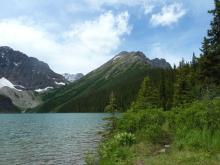
I don't know enough about rhodos to comment, but that is how R. albiflorum is described in Flora of Alberta, with flowers "1-3 in the axils of the previous year's leaves and lateral on the stem"... a clever adaptation, if that is so.
I've actually only seen the waterfall from that vantage point, but the water does come coursing down a ways from the melting snow banks (and whatever else... possible tarn?) above... more tumbling laterally than vertically. This photo may show it a little better...
(We are walking up the valley on the right side of that dip slope on the right in the picture above.)
I have only seen that Petasites in the alpine/subalpine zones, where it tends to be quite restricted in size (leaves up to ~10cm?) (It is not limited to high elevations though.)
Thanks for the comments!
More exquisite little rock gardens, of Phyllodoce empetriformis, Cassiope mertensiana and Phyllodoce glanduliflora:
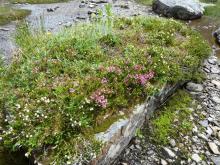

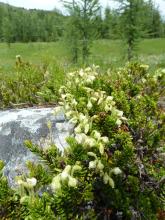
Scenery:
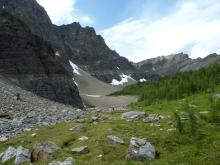
A carpet of water-loving mosses, liverworts, horsetails, etc.:
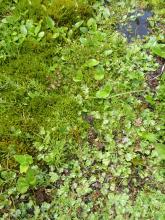
And (ignoring for the moment my foreshadowing of things to come ;D ), magnificent stands of Anemone occidentalis with advanced seedheads:
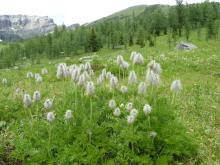
Dramatic postcard views... and as we ascend, some Veratrum viride var. eschscholtzianum have just emerged:

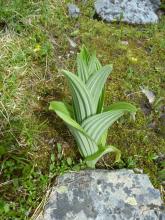
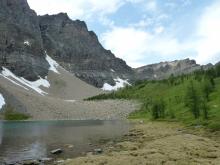
Lori S. (not verified)
Re: Taylor Lake - Panorama Meadows, Banff N.P., Aug. 2/11
Wed, 08/03/2011 - 5:07pmRanunculus pygmaeus was very abundant on the boggy shores of the tarns... and even blooming underwater up to about 20' out from the wet shoreline( :o):
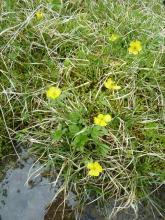

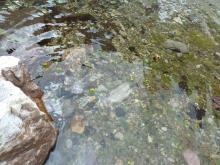
Antennaria sp.... very common also:
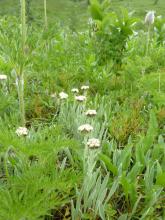
Flower buds on Veratrum viride var. eschscholtzianum, none yet in bloom:
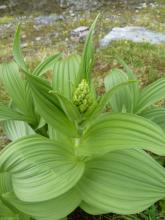
Continuing along...
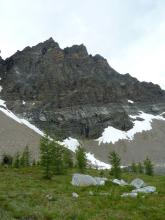
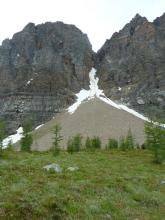
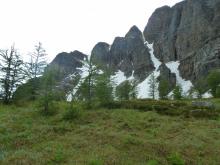
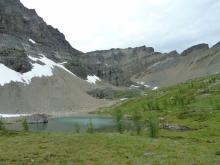
And we come upon some Anemone occidentalis with flowers that are just spent... maybe if we go higher... ?
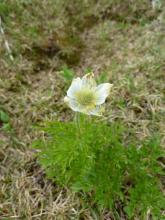
Lori S. (not verified)
Re: Taylor Lake - Panorama Meadows, Banff N.P., Aug. 2/11
Wed, 08/03/2011 - 8:51pmOkay, onwards and upwards then... to some nice outcrops:

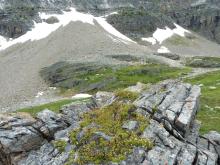
Erigeron aureus growing in the joints of the rock, and

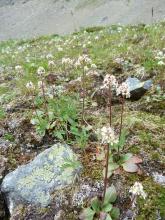
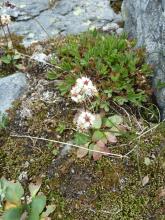
Leptarrhena pyrolifoliaSaxifraga occidentalis:More of the countless Anemone occidentalis in this valley...
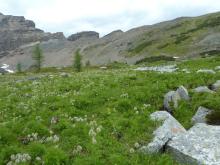
Also an unimaginable number of blossoms of Cassiope mertensiana:
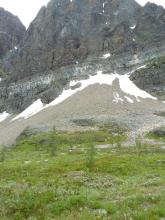

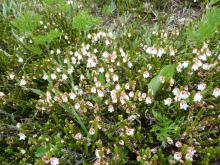
The head of the valley with a terminal moraine in evidence...
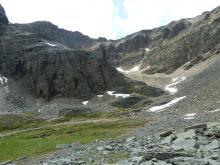
Lori S. (not verified)
Re: Taylor Lake - Panorama Meadows, Banff N.P., Aug. 2/11
Wed, 08/03/2011 - 10:02pmThe rock... imagine this rolling down from the cliff several hundreds of meters away.... (on second thought, I suppose it might have been "rafted" on glacial ice?)
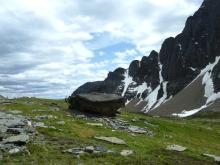
(Rather easier to climb up the 10' than to climb down, by the way... I was asked to "spot" for the descent, and it was then admitted that it was a bit silly to risk it... a little more remote than the climbing wall at home, should an ankle get twisted.)
Slabs of rock...
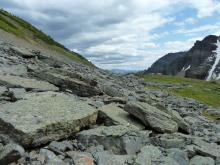
And at this fairly high elevation, some spectacular, and large colonies of Pedicularis

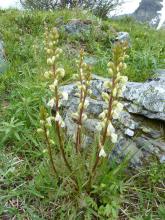

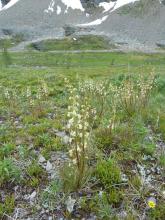
capitatacontorta:And near the end of our trek, in the remaining snow patches, a slight pinkish tinge ("watermelon snow") caused by the hematochrome pigment in a green algae, Chlamydomonas augustae (formerly C. nivalis) that is common in this area:
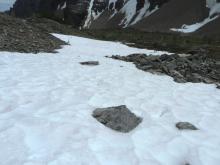
Avalanche debris (broken branches), and diminutive subalpine larches (Larix lyallii) that are only just starting to leaf out at the beginning of August.... and one twisted and broken by an avalanche in the season past...
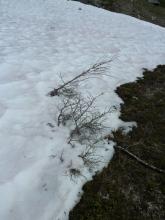
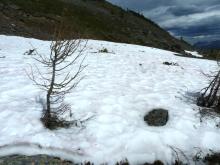
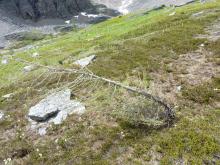
Cliff Booker
Re: Taylor Lake - Panorama Meadows, Banff N.P., Aug. 2/11
Wed, 08/03/2011 - 11:46pmMagnificent trek, Lori, beautifully depicted.
A few statistics please - mileage estimate, altitude gain, hours to get to the trailhead, total hours of hike including photography stops?
The anemones are stunning (with perfect flowers still to come - exemplary foreshadowing), do you grow these in your garden?
Enjoying every second of this adventure - it feels like we are peering out of your backpack! :D
Flowering meadows are extremely hard to photograph, they rarely convey the quantity or quality of the blooms and the photographer is usually disappointed with the results - millions of tiny flowers are practically impossible to depict. Please don't label your meadow shots 'inadequate' - they are every bit as good as your other landscapes.
Trond Hoy
Re: Taylor Lake - Panorama Meadows, Banff N.P., Aug. 2/11
Thu, 08/04/2011 - 12:29amAs I said above, it is remarkable how exuberant the flora is there, especially flowering plants.
Btw, have you ever looked inside a twinflower?
Toole (not verified)
Re: Taylor Lake - Panorama Meadows, Banff N.P., Aug. 2/11
Thu, 08/04/2011 - 1:18amReally nice to see Stenanthium occidentale Lori.
I had very good germination from NARGS seed back in April 06 however the youngsters have grown so slowly in my peat based mix. I checked the pot today and their growths are just starting to break the surface so they are still with me.... ;D
Any hints on their preferred habitat ?.--i understand they like cool moist positions --maybe i need to place some sphagnum moss in the mix?.
Cheers Dave.
Lori S. (not verified)
Re: Taylor Lake - Panorama Meadows, Banff N.P., Aug. 2/11
Thu, 08/04/2011 - 10:32amThanks for the comments, Cliff! Stats to follow... I don't grow Anemone occidentalis - I tend to grow more things that I don't have the opportunity to see. Does anyone else grow it?
Trond, no, I have not, but will do so at the next opportunity! (That's another very interesting, intricate flower detail photo! Thanks for showing us!)
Dave, it would seem as though cool and moist is the way to go for Stenanthium... though they also grow in much drier forests.
Now where was I? Oh, yes, out on a snow drift:
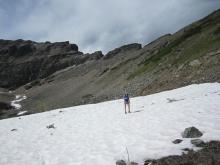
Where the snow has just melted off, at the head of the valley and the base of the scree slopes, there are tracts of fresh, pristine Anemone occidentalis in bloom:
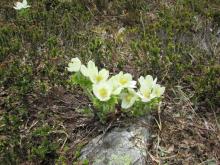

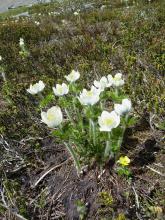
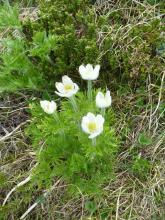
And perfect mats of Dryas octopetala:
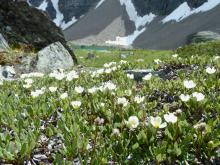
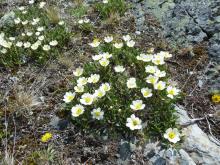
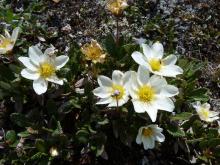
Lori S. (not verified)
Re: Taylor Lake - Panorama Meadows, Banff N.P., Aug. 2/11
Thu, 08/04/2011 - 1:02pmKruppelholz downslope of the last snow:
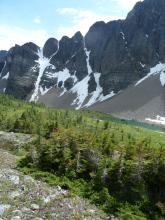
Anemone lithophila; Penstemon ellipticus in bud and in bloom (on top of the big rock); Salix sp. and Saxifraga bronchialis; Potentilla sp.:
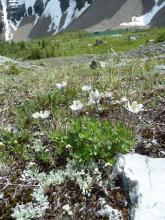
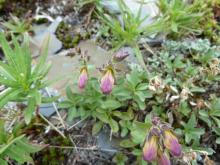
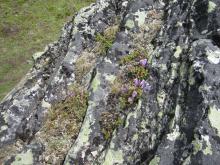
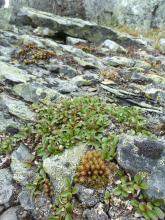
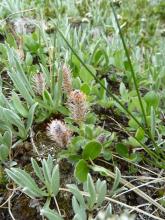
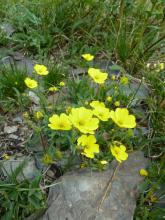
And heading down through the larches, a fallen giant (comparatively) and a couple of the bigger ones still standing:
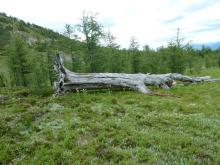
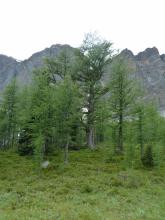
Lori S. (not verified)
Re: Taylor Lake - Panorama Meadows, Banff N.P., Aug. 2/11
Thu, 08/04/2011 - 1:22pmRich meadows in the sparse subalpine larch forest, with a great density of Trollius albiflorus and many other species, including the yellow daisies of Arnica lonchophylla:
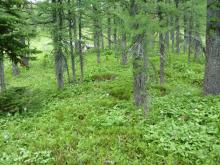
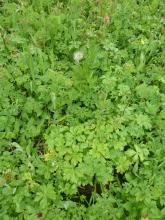
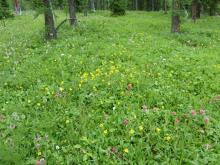
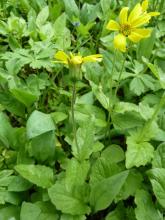
Habenaria dilatata:
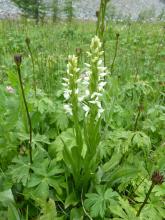
Descending through the forest below Taylor Lake, one Trollius albiflorus still in bloom in a boggy spot along the trail:
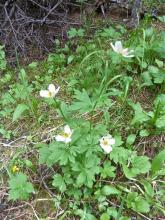
And in closing, what has become my favourite lichen (hey, doesn't everyone have a favourite lichen? ;D ;)), Icmadophila ericetorum or "fairy puke":
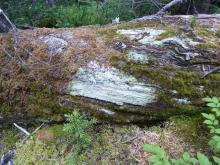
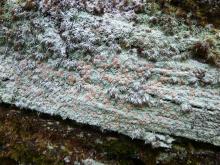
Finis!
The promised stats:
The drive is about 1 3/4 hours to the trailhead. The hike, at a quick pace with no stops, is 1 1/2 hours to Taylor Lake, 6.3 km with an elevation gain of 585m. Then, up to Panorama Meadows/Ridge was another ~2km, and ~250m elevation gain... time spent there, about 3.5 hours, then down from the lake again in a little over an hour.
Cliff Booker
Re: Taylor Lake - Panorama Meadows, Banff N.P., Aug. 2/11
Fri, 08/05/2011 - 12:23amMany thanks Lori ... it's always difficult to judge distances and times from photo essays, your stats now put things in context. An excellent day in the mountains with no overnight stops and (thankfully) no camping! :D
I enjoy my creature comforts too much now!
Stephen Barstow
Re: Taylor Lake - Panorama Meadows, Banff N.P., Aug. 2/11
Fri, 08/05/2011 - 1:08amThanks too from me for the great pictures - two on my wants list there too - the Agoseris and Claytonia lanceolata!
Trond: Thanks for showing the secret beauty of the Twinflower...
Anne Spiegel
Re: Taylor Lake - Panorama Meadows, Banff N.P., Aug. 2/11
Fri, 08/05/2011 - 3:50amNow I have, thanks for posting this picture. A 10x lens is a must for any walk. So many beautiful things not noticed by the naked eye.
Trond Hoy
Re: Taylor Lake - Panorama Meadows, Banff N.P., Aug. 2/11
Fri, 08/05/2011 - 1:02pmI hadn't been back in a week! Think I had been on my knees and stomach more than on my feet :o 8)
It is a rich world and richer still in details ;)
Lori S. (not verified)
Re: Taylor Lake - Panorama Meadows, Banff N.P., Aug. 2/11
Sat, 08/06/2011 - 10:08amIn that case, it would have been more than a dayhike... best to bring camping gear. ;D ;)